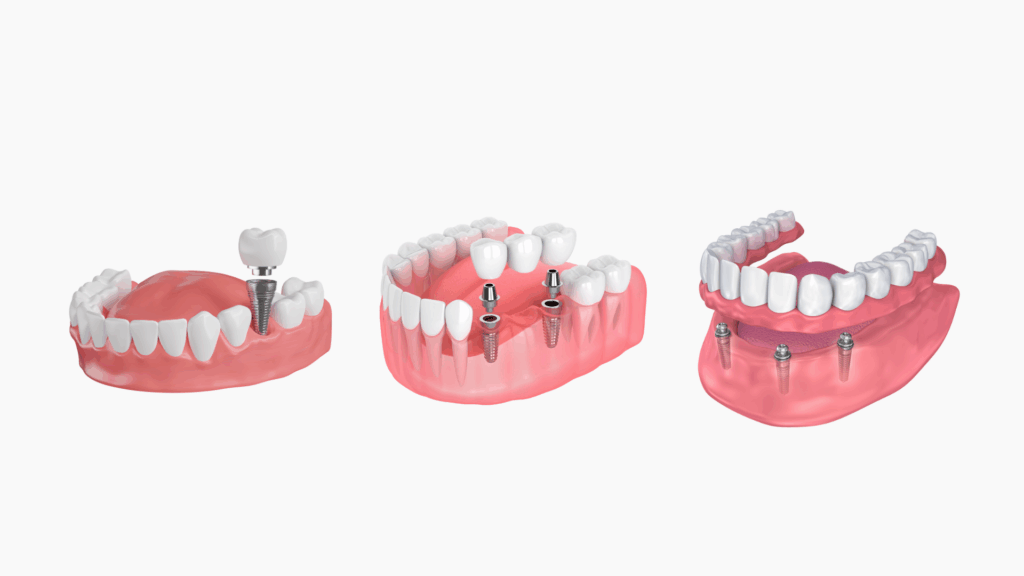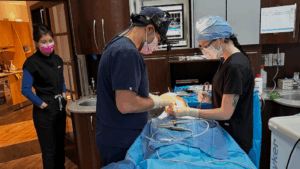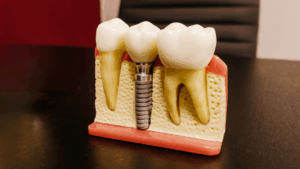Dental implantology has undergone a remarkable evolution over the past two decades, both in Canada and in Quebec. Once reserved for complex and costly cases, dental implantation is now a reliable and accessible solution for patients who wish to replace missing teeth and regain a natural, functional smile, based on their specific oral health needs.
Technological advances—particularly 3D imaging and digital planning—have transformed the way dental implants are placed. This technological update changes everything: from bone evaluation to implant placement, including the fabrication of high-precision surgical guides.

At Seaforth Oral Surgery, our oral and maxillofacial surgeons use the most advanced digital tools to ensure safety, precision, and durability. We guide every patient in choosing the solution best suited to their needs, whether it involves denture stability, prevention of bone deterioration, or aesthetics.
Whether you are looking for the best place for a dental implant in Montreal or simply exploring your treatment options, it is essential to understand why 3D imaging and planning has become indispensable in modern implantology. Taking the time to properly assess your needs and make the right choice is fundamental for the best possible outcome.
What Is Precision Dental Implantology?
Dental implantology involves replacing the root of a missing tooth with a dental implant—usually a titanium screw—that integrates with the jawbone. A dental implant is a restorative solution that serves as a support for a crown, a fixed bridge, or even a complete denture. Implant-based restorations ensure personalized and long-lasting solutions.
The role of the dental implant specialist
A dental implant specialist — or an oral surgeon specializing in implantology — is highly trained to evaluate, plan, and perform implant placement with precision. While a general dentist provides a wide range of dental care, an oral and maxillofacial surgeon concentrates on complex surgical procedures, including implant placement, bone grafting, and jaw reconstruction, ensuring optimal outcomes for patients.
Traditional vs Digital Implantology
- Traditional: Based on 2D X-rays and clinical experience. While reliable, this method has limitations in terms of precision.
- Computer-assisted: 3D imaging (CBCT, intraoral scanning) and digital planning make it possible to visualize anatomical details before surgery. This technology also provides precise information about bone structure and tissues.
The long-term benefits
3D-guided dental implantation reduces the risk of complications, increases the long-term success of the implant, and ensures optimal aesthetics and function. In short, it’s a treatment designed for you to smile, speak, and chew with confidence for years to come.
3D Imaging: The Foundation of a Successful Dental Implant
Technologies we use
At Seaforth Oral Surgery, we combine advanced technology with personalized care to ensure the best outcomes.
- Cone Beam Computed Tomography (CBCT): A precise 3D scan that reveals bone density and key anatomical structures such as sinuses and nerves.
- Intraoral Scans: Highly accurate digital impressions that replicate your teeth and bite in detail.
Together, these 3D imaging tools help us plan your treatment and choose the most suitable implant material based on your bone structure and goals.
Detailed bone assessment
With these images, the dental implant specialist can check whether you have enough bone for implant fixation. If not, options such as bone grafting may be considered. Bone density directly influences the choice of treatment and the potential need for grafting.
Detecting anatomical risks
The scans reveal roots, soft tissues, sinuses, and nearby nerves. This prevents complications during the surgical procedure and maximizes success. Evaluating the condition of each tissue before implant placement is essential to ensure oral health and treatment success.
Digital Planning: From Diagnosis to Surgical Guide
Specialized software
The dental implant specialist uses software to simulate the ideal implant position: angle, depth, and relation to adjacent teeth.
This simulation is a crucial step in the implant process.
Fabrication of surgical guides
These plans are used to design a custom surgical guide, produced through 3D printing. This guide acts as a model that directs dental implant placement during surgery.
It also facilitates the precise placement of abutments, whether healing or permanent, on the implants.
Error reduction
This approach reduces the need for adjustments during the procedure, shortens surgery time, and increases patient comfort.
Guided Surgery: Safety and Comfort for the Patient
Key steps
- Digital planning with scans and software.
- Custom fabrication of the surgical guide.
- Placement of dental implants with the guide, under local anaesthesia and sedation.
- Bone healing and implant integration.
- Placement of the abutment and the crown, bridge, or denture as needed.
The benefits
- Precision: the bone base is respected to the nearest millimetre.
- Shorter duration: the surgery is faster and often less invasive.
- Greater comfort: less postoperative pain and faster recovery.
Comparison
Without a guide, implant placement relies more heavily on visual estimation. With 3D imaging and planning, the technique is reproducible and predictable, improving the success rate.

Why Choose a Dental Implant Specialist in Montreal That Uses 3D Technology?
In Montreal, patients have access to leading clinics like Seaforth Oral Surgery, which combines expertise, modern materials, and 3D technologies.
- Local expertise: our dental implant specialists are trained in oral and maxillofacial surgery.
- Advanced equipment: CBCT scanners, 3D software, and surgical guides.
- Patient experience: numerous testimonials confirm a high level of trust, comfort, and lasting results.
Criteria for Finding the Best Place for a Dental Implant
To choose the best place for a dental implant in Montreal, consider:
- Training and experience of the dental implant specialist.
- Availability of technologies (3D imaging, surgical guides).
- Postoperative follow-up: regular check-up appointments to adjust treatment and ensure proper healing.
- Treatment options: fixed bridges, dentures, or single implants, depending on your needs.
- Cost and financing: the price of dental implants varies depending on the number of implants, materials, and procedure complexity. On average, in Montreal, a dental implant costs between $3,000 and $6,000—an investment in health, appearance, and durability.
Conclusion: 3D Technology, a Real Asset for Your Smile
The combination of 3D imaging, digital planning, and surgical guides is redefining dental implantology in Montreal. It ensures improved implant placement, more predictable bone integration, and dental restoration that meets your functional and aesthetic needs.
Book your appointment today with our oral surgeons in Montreal to discuss your dental implant options and discover why we are a leading practice for dental implants in Montreal.
Dental implantology has undergone a remarkable evolution over the past two decades, both in Canada and in Quebec. Once reserved for complex and costly cases, dental implantation is now a reliable and accessible solution for patients who wish to replace missing teeth and regain a natural, functional smile, based on their specific oral health needs.
Technological advances—particularly 3D imaging and digital planning—have transformed the way dental implants are placed. This technological update changes everything: from bone evaluation to implant placement, including the fabrication of high-precision surgical guides.

At Seaforth Oral Surgery, our oral and maxillofacial surgeons use the most advanced digital tools to ensure safety, precision, and durability. We guide every patient in choosing the solution best suited to their needs, whether it involves denture stability, prevention of bone deterioration, or aesthetics.
Whether you are looking for the best place for a dental implant in Montreal or simply exploring your treatment options, it is essential to understand why 3D imaging and planning has become indispensable in modern implantology. Taking the time to properly assess your needs and make the right choice is fundamental for the best possible outcome.
What Is Precision Dental Implantology?
Dental implantology involves replacing the root of a missing tooth with a dental implant—usually a titanium screw—that integrates with the jawbone. A dental implant is a restorative solution that serves as a support for a crown, a fixed bridge, or even a complete denture. Implant-based restorations ensure personalized and long-lasting solutions.
The role of the dental implant specialist
A dental implant specialist — or an oral surgeon specializing in implantology — is highly trained to evaluate, plan, and perform implant placement with precision. While a general dentist provides a wide range of dental care, an oral and maxillofacial surgeon concentrates on complex surgical procedures, including implant placement, bone grafting, and jaw reconstruction, ensuring optimal outcomes for patients.
Traditional vs Digital Implantology
- Traditional: Based on 2D X-rays and clinical experience. While reliable, this method has limitations in terms of precision.
- Computer-assisted: 3D imaging (CBCT, intraoral scanning) and digital planning make it possible to visualize anatomical details before surgery. This technology also provides precise information about bone structure and tissues.
The long-term benefits
3D-guided dental implantation reduces the risk of complications, increases the long-term success of the implant, and ensures optimal aesthetics and function. In short, it’s a treatment designed for you to smile, speak, and chew with confidence for years to come.
3D Imaging: The Foundation of a Successful Dental Implant
Technologies we use
At Seaforth Oral Surgery, we combine advanced technology with personalized care to ensure the best outcomes.
- Cone Beam Computed Tomography (CBCT): A precise 3D scan that reveals bone density and key anatomical structures such as sinuses and nerves.
- Intraoral Scans: Highly accurate digital impressions that replicate your teeth and bite in detail.
Together, these 3D imaging tools help us plan your treatment and choose the most suitable implant material based on your bone structure and goals.
Detailed bone assessment
With these images, the dental implant specialist can check whether you have enough bone for implant fixation. If not, options such as bone grafting may be considered. Bone density directly influences the choice of treatment and the potential need for grafting.
Detecting anatomical risks
The scans reveal roots, soft tissues, sinuses, and nearby nerves. This prevents complications during the surgical procedure and maximizes success. Evaluating the condition of each tissue before implant placement is essential to ensure oral health and treatment success.
Digital Planning: From Diagnosis to Surgical Guide
Specialized software
The dental implant specialist uses software to simulate the ideal implant position: angle, depth, and relation to adjacent teeth.
This simulation is a crucial step in the implant process.
Fabrication of surgical guides
These plans are used to design a custom surgical guide, produced through 3D printing. This guide acts as a model that directs dental implant placement during surgery.
It also facilitates the precise placement of abutments, whether healing or permanent, on the implants.
Error reduction
This approach reduces the need for adjustments during the procedure, shortens surgery time, and increases patient comfort.
Guided Surgery: Safety and Comfort for the Patient
Key steps
- Digital planning with scans and software.
- Custom fabrication of the surgical guide.
- Placement of dental implants with the guide, under local anaesthesia and sedation.
- Bone healing and implant integration.
- Placement of the abutment and the crown, bridge, or denture as needed.
The benefits
- Precision: the bone base is respected to the nearest millimetre.
- Shorter duration: the surgery is faster and often less invasive.
- Greater comfort: less postoperative pain and faster recovery.
Comparison
Without a guide, implant placement relies more heavily on visual estimation. With 3D imaging and planning, the technique is reproducible and predictable, improving the success rate.

Why Choose a Dental Implant Specialist in Montreal That Uses 3D Technology?
In Montreal, patients have access to leading clinics like Seaforth Oral Surgery, which combines expertise, modern materials, and 3D technologies.
- Local expertise: our dental implant specialists are trained in oral and maxillofacial surgery.
- Advanced equipment: CBCT scanners, 3D software, and surgical guides.
- Patient experience: numerous testimonials confirm a high level of trust, comfort, and lasting results.
Criteria for Finding the Best Place for a Dental Implant
To choose the best place for a dental implant in Montreal, consider:
- Training and experience of the dental implant specialist.
- Availability of technologies (3D imaging, surgical guides).
- Postoperative follow-up: regular check-up appointments to adjust treatment and ensure proper healing.
- Treatment options: fixed bridges, dentures, or single implants, depending on your needs.
- Cost and financing: the price of dental implants varies depending on the number of implants, materials, and procedure complexity. On average, in Montreal, a dental implant costs between $3,000 and $6,000—an investment in health, appearance, and durability.
Conclusion: 3D Technology, a Real Asset for Your Smile
The combination of 3D imaging, digital planning, and surgical guides is redefining dental implantology in Montreal. It ensures improved implant placement, more predictable bone integration, and dental restoration that meets your functional and aesthetic needs.
Book your appointment today with our oral surgeons in Montreal to discuss your dental implant options and discover why we are a leading practice for dental implants in Montreal.









